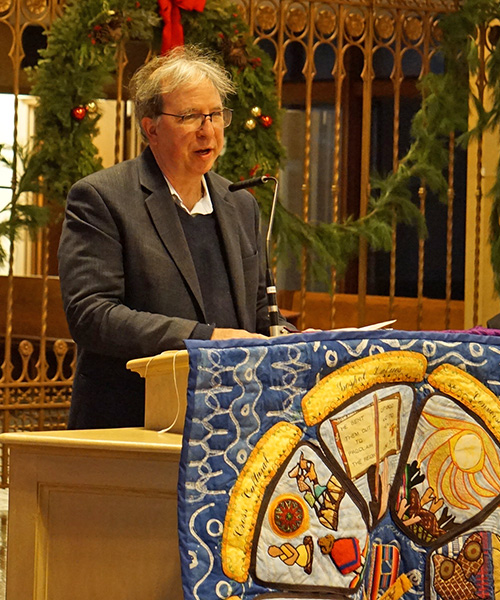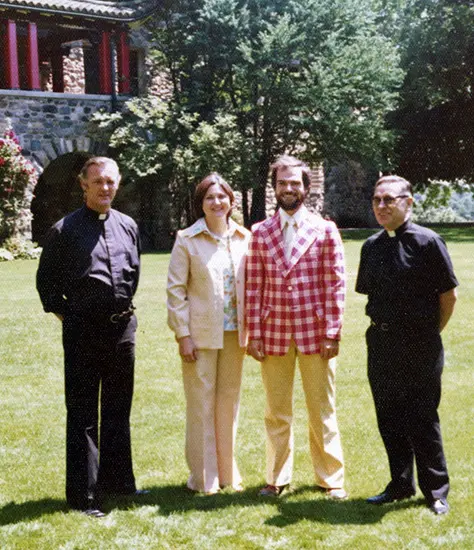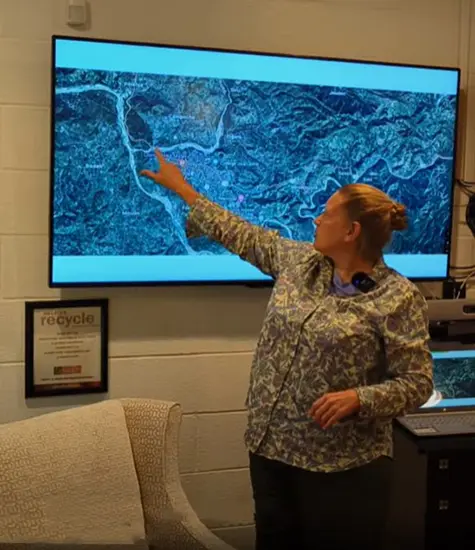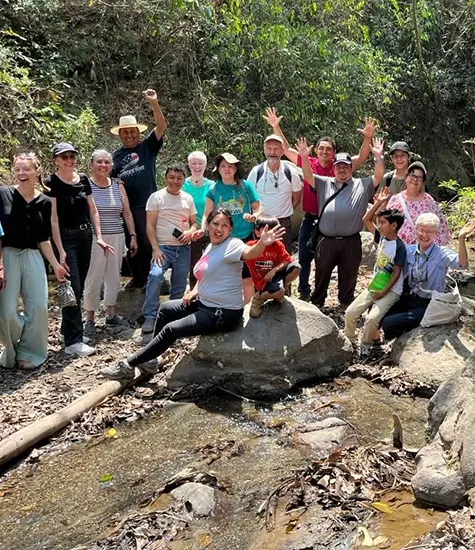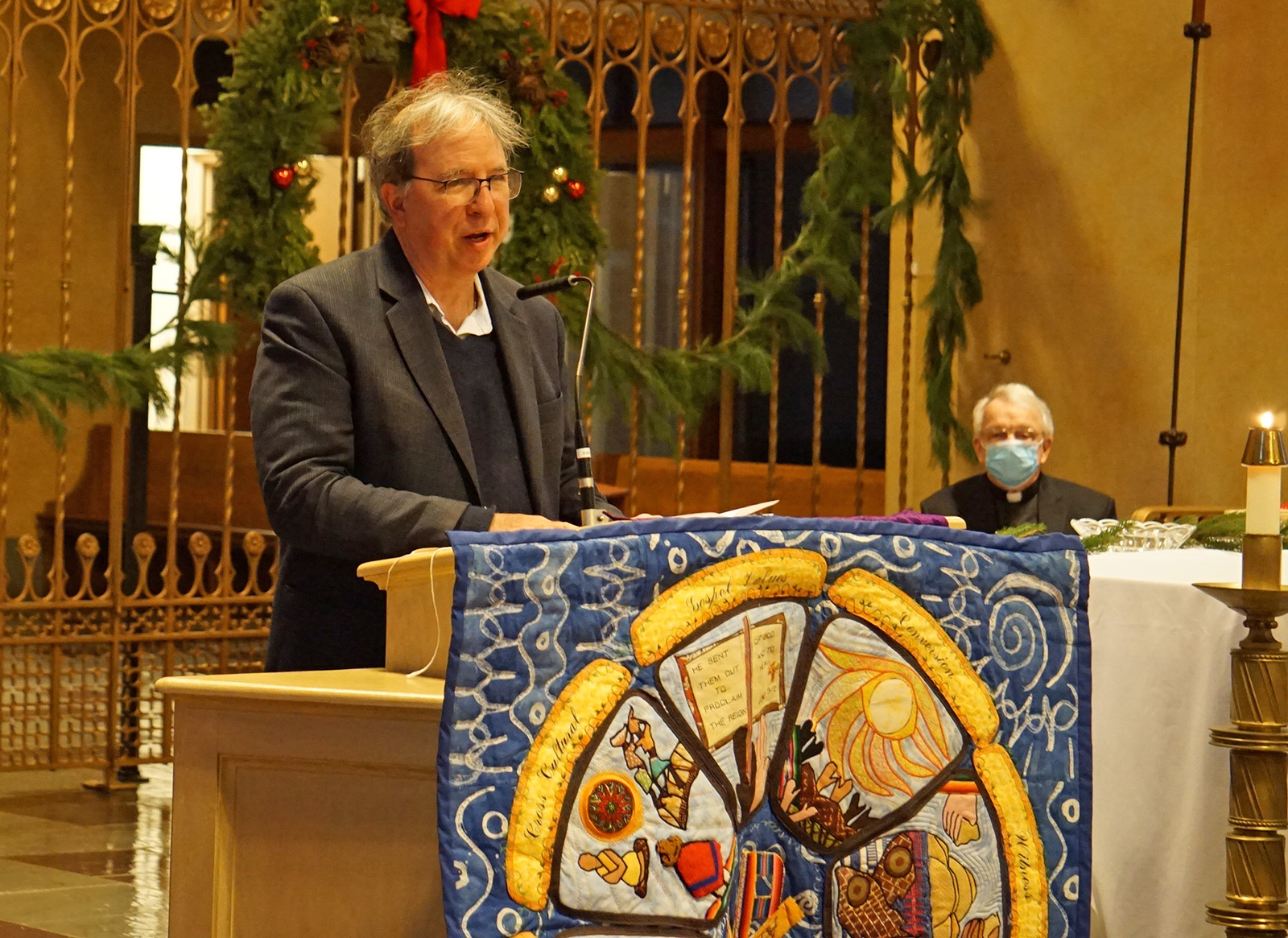
Robert Ellsberg speaking at the Dec. 11, 2021 Sending of Maryknoll Lay Missioners in the Queen of the Apostles Chapel of the Maryknoll Fathers and Brothers. (Photo by Patrick Norberto)
Dear friends,
It is a great joy to be invited to share some thoughts with you today about this occasion, as you receive the blessing of this community, on behalf of Maryknoll and the church, which is the pilgrim people of God, as you embark on your mission.
This is called a “Sending Ceremony,” and that is echoed in the reading from Isaiah, where God asks the prophet, “Whom shall I send? Who will go for us?” and he replies: “Here I am, send me!”
And that is a reminder of who is doing the sending here, which is ultimately not Maryknoll. Your presence today is in response to a question that was at some point planted in your hearts: “Whom shall I send?” And you have answered, “Here I am, send me!” You have consented to embark on a journey rooted in God’s own overflowing love, and in turn to find God among the people you will meet and accompany in their joys and sorrows, their struggles and celebrations.
Pope Francis has drawn a distinction between two kinds of faith — a laboratory faith and a journey faith — and I think that distinction has enormous implications for mission.
 Our faith, he says, is not a laboratory faith — a “compendium of abstract truths” that are all connected like mathematical syllogisms. Such a faith emphasizes certainty. It is threatened by uncertainty and doubt. It has all the answers in advance. Mission in this sense is about going out and proclaiming these truths.
Our faith, he says, is not a laboratory faith — a “compendium of abstract truths” that are all connected like mathematical syllogisms. Such a faith emphasizes certainty. It is threatened by uncertainty and doubt. It has all the answers in advance. Mission in this sense is about going out and proclaiming these truths.
In contrast to this model, Pope Francis speaks of a “journey faith,” in which we find God along the way, in history, in the twists and turns of experience, in our unexpected encounters and relationships with others. In this model, we don’t have all the answers in advance. We learn and grow along the way. Stumbling, doubts, and uncertainty are part of the journey. It can be risky, but it is dynamic — it is open to conversion and learning new things. It is open to the surprising promptings of the Holy Spirit.
What it demands on our part is a continuous willingness to go beyond ourselves, to move beyond our certainties, our comfort zones, our familiar shores and harbors, to cast our nets into the deep waters, to go where the spirit is calling us.
The bold declaration “Here I am! Send me!” is not just something to say the day you arrived at Maryknoll, or today in this sending ceremony. It is something to be renewed and repeated over and over.
Because there will be days ahead when you may question this bold declaration, when you will say, “What was I thinking? What was this for? Could you send me somewhere else?” But you are not being sent to a particular place, whether El Salvador, or Brazil, or Kenya. They are not your final destination. The sending and being sent is itself the place — an ongoing, daily invitation to meet God along the way, on the journey, among God’s pilgrim people. Some days you will travel with the sun at your back and know exactly where you are going. On other days you may travel in darkness.
But you have chosen to accept that invitation, that call. And for those who respond to that call each day is an opportunity to say, “Here I am! Send me!”
As a matter of fact, you don’t actually have to go anywhere at all to respond to this call.
Madeleine Delbrel, a French Catholic in the 1930s, called herself and the companions who joined her “missionaries without a boat”—not traveling overseas, but crossing the borders of faith to bear witness to the gospel in friendship and solidarity with their neighbors in a working class city near Paris.
She called her spiritual practice her “prayer of the agenda.” It was simply a heightened awareness of the presence of God in all the ordinary activities of life—whether meeting people, answering the phone, or running errands. In these ordinary circumstances, she insisted, a person could experience the deepest spiritual dimensions of life.
“Each tiny act,” she wrote, “is an extraordinary event, in which heaven is given to us, in which we are able to give heaven to others. It makes no difference what we do… Whatever it is, it’s just the outer shell of an amazing inner reality: the soul’s encounter, renewed at each moment, in which the soul grows in grace and becomes ever more beautiful for her God. Is the doorbell ringing? Quick, open the door! It’s God coming to love us…. Is it time to sit down for lunch? Let’s go—it’s God coming to love us. Let’s let him.”
You may be traveling to different cultures, learning new languages, working on important projects or ministries. But ultimately your mission will be about the ordinary activities of life, trying to remember that all these outward activities are simply the outer shell of an amazing inner reality.
The meaning of that came through to me very deeply in a conversation with a great Maryknoll missioner, Father Steve DeMott, who worked in Chile and ultimately died prematurely from a brain tumor. He told me that sometimes he imagined that he had been given an art project to work on, and he had proceeded in an indifferent way, working a bit here, a bit there, and not using his time as best he could. And suddenly he heard a voice say, “Time’s up.” And he felt such regret. But then he imagined Jesus saying to him, “You know, Steve, it wasn’t really about the art project.”
Whatever the projects or ministries that will be given to you in the next few years, some of which may bear great fruit, or in other cases feel woefully incomplete, I hope, at the end of the day, that you will remember: it was not really about the art project, so much as spreading mustard seeds of God’s Kingdom.
We are all on a great journey. But sometimes, like today, there are specific moments that serve as guideposts on the way.
 One of the great teachers in my life, and an example of a “journey faith,” was Dorothy Day, the founder of the Catholic Worker movement, who died in 1980. In her autobiography she traced the ways that God had encountered her throughout her life. But there were two occasion in particular when she confronted a vocational turning point, when she answered “Here I am, send me!” and set herself in faith upon an uncertain path.
One of the great teachers in my life, and an example of a “journey faith,” was Dorothy Day, the founder of the Catholic Worker movement, who died in 1980. In her autobiography she traced the ways that God had encountered her throughout her life. But there were two occasion in particular when she confronted a vocational turning point, when she answered “Here I am, send me!” and set herself in faith upon an uncertain path.
The first was when she was living with a man she loved and found that she was pregnant. She felt an irresistible call to have her child baptized and to become a Catholic, though this would mean separating from the man she loved, since he was a committed agnostic and anarchist who did not believe in marriage. And so they did separate and she entered into a kind of desert for some years, wondering where God was calling her, what the point of this sacrifice had been. I connect that moment to the response of another young, unmarried woman, the patron of Maryknoll, who accepted in faith her call to enter into God’s mysterious plan; ‘Behold the handmaid of the Lord. May it be done unto me according to God’s will.”
That moment led eventually to a second great moment, five years later, on the Feast of the Immaculate Conception, December 8, 1932, when, as a journalist, she was covering a communist-led Hunger March of the Unemployed in Washington, DC. And she wondered why Catholics were not leading such a march. Since her conversion she had felt herself alienated from her old comrades in the radical movement. And so she went to the Shrine of the Immaculate Conception and prayed there “with tears and anguish” for some way of connecting her faith and her commitment to the poor and the oppressed.
And when she returned to New York she found a strange Frenchman waiting for her — Peter Maurin, a peasant-philosopher and apostle, who began talking to her about starting a newspaper and a movement to share the radical message of the Gospel. It was some while before she realized that this man and his message were the answer to her prayer. And this was the origin of the Catholic Worker movement, which was launched on May 1, 1933, and her lifetime of service among the poor and her tireless work for peace and justice.
My own journey was grafted into her story 46 years ago when I first went to work at the Catholic Worker, and stayed on for the last five years of her life. It was during those years, when I also served as editor of the Catholic Worker newspaper that I also decided to become a Catholic. All of this pointed in the direction of my life’s work and vocation, but at the time when I returned to college in 1980 I had no idea where any of this was headed, where I was being called.
Yet there was a thread that led from those years to my later studying Spanish at the Maryknoll language school in Bolivia. And there in the library I discovered books on liberation theology published by Orbis and decided to go back to school to study theology. And it was there, some years later that I received a call (literally, on the phone) from Maryknoll inviting me to become the editor of Orbis Books.
And now 34 years later, here I am, at this Sending Ceremony. You have answered God’s question, whom shall I send, and it has called you here. And to be with you today I am reminded of the ways that invitation came to me so many years ago, and all the difference it has made along the way. And the ways that journey continues to unfold. This week, in New York City, on the Feast of the Immaculate Conception, there was a special Mass at St. Patrick’s Cathedral to recognize the completion of the archdiocesan phase of the cause for Dorothy’s canonization.
Dorothy would not care if she were named a saint. For her, what was important was to be a saint—which is another word for what Pope Francis calls a “missionary disciple.”
To be a missionary disciple, he says, “means being constantly ready to bring the love of Jesus to others, and this can happen unexpectedly and in any place: on the street, in a city square, during work, on a journey.”
You are about to embark on a great journey, but that readiness to bring the love of Jesus to others will not begin on the day you arrive in your mission assignment, and it will not end on the day you return.
It began from the day you first said, “Here I am! Send me!” You may not have said it in those words. It might have been expressed as a yearning for some deeper meaning; it might have been some feeling of dis-ease or frustration with the well-worn path, with all the answers about life’s purpose laid out in advance. It was in the midst of that questioning or dis-ease that you heard a question that sounded like “Whom shall I send?” And your answer has led you here, as it will lead you on to your mission assignment and beyond.
The word mission comes from the Latin word that means sent. It is not a place; it is not something you do. It is a way of being in the world, a condition of being sent, a life on pilgrimage, in the heart of the people.
Pope Francis says, “My mission of being in the heart of the people is not just a part of my life or a badge I can take off; it is not an ‘extra’ or just another moment in life. Instead, it is something I cannot uproot from my being without destroying my very self. I am a mission on this earth; that is the reason why I am here in this world. We have to regard ourselves as sealed, even branded, by this mission of bringing light, blessing, enlivening, raising up, healing and freeing.”
Today’s ceremony is not about sending you on mission, but recognizing and blessing the mission that you are, your identity as those who are sealed and branded by God’s mission of light, love and solidarity. For those of us witnessing and blessing you in this sending ceremony, it is an opportunity to renew our own mission, our own sense of purpose and reason for being in this world. We remember the occasions in our own lives when we heard a voice call, “Whom shall I send?” and the ways we responded by declaring, “Here I am! Send me.” And we renew that declaration today.
You can watch a recording of the entire Sending Ceremony here.

